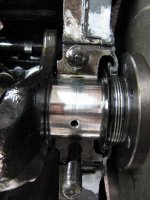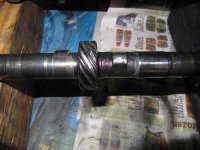Online
My TD was run by a PO without oil pressure. I've dug into the engine, and I have a question about the crank.
The rod journals are pretty well chewed up, so I clearly need to get them reground. Currently, the journals are 0.020" under, so there's plenty of room to grind them some more.
The problem is the main bearing journals, which are now 0.040" under. According to the shop manual, the maximum grind is 0.040". However, I noticed that bearings of 0.050" and even 0.060" are available, which puzzles me a bit.
So,
1. Is the 0.040" limit for the mains really valid? Can you really grind it 0.050 or 0.060 under, or is that a bad idea?
2. If so, what do you do if it needs to be reground further? Can the crank be rehardened, or is this one of those things that is possible in theory but not in practice?
3. How do I tell if the journals really need regrinding? The front and center don't look bad to me, but the rear one has a clear score line around it, maybe a couple mils deep, just enough to be visible and feel it with a fingernail. It's actually in the center, so it's under the oil groove, not really in the bearing surface.
I've attached a picture of the rear journal, although I realize it's hard to evaluate a crank just from a picture like this.

The rod journals are pretty well chewed up, so I clearly need to get them reground. Currently, the journals are 0.020" under, so there's plenty of room to grind them some more.
The problem is the main bearing journals, which are now 0.040" under. According to the shop manual, the maximum grind is 0.040". However, I noticed that bearings of 0.050" and even 0.060" are available, which puzzles me a bit.
So,
1. Is the 0.040" limit for the mains really valid? Can you really grind it 0.050 or 0.060 under, or is that a bad idea?
2. If so, what do you do if it needs to be reground further? Can the crank be rehardened, or is this one of those things that is possible in theory but not in practice?
3. How do I tell if the journals really need regrinding? The front and center don't look bad to me, but the rear one has a clear score line around it, maybe a couple mils deep, just enough to be visible and feel it with a fingernail. It's actually in the center, so it's under the oil groove, not really in the bearing surface.
I've attached a picture of the rear journal, although I realize it's hard to evaluate a crank just from a picture like this.

Last edited:

 Hi Guest!
Hi Guest!

 smilie in place of the real @
smilie in place of the real @
 Pretty Please - add it to our Events forum(s) and add to the calendar! >>
Pretty Please - add it to our Events forum(s) and add to the calendar! >> 




